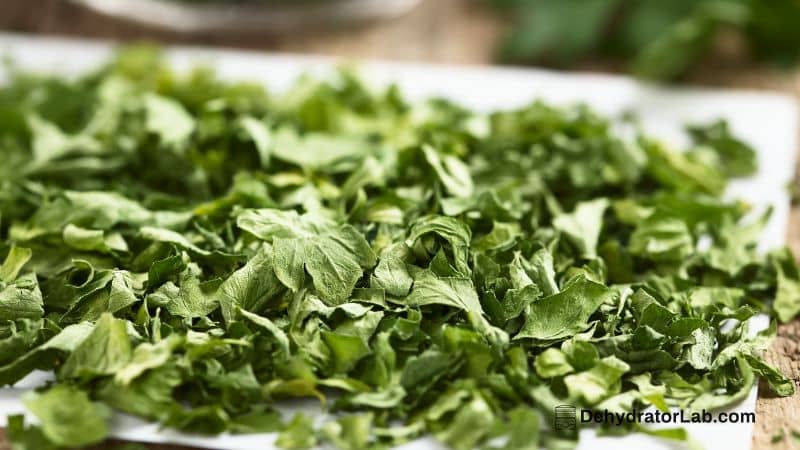In this guide, we will walk you through the process of dehydrating canned diced tomatoes, a method that is not only cost-effective but also an excellent way to conserve space while maintaining the nutritional value of the food.
This easy step-by-step tutorial also includes tips on how to use dehydrated tomatoes and advice on the best storage methods.

As an Amazon Associate, I earn from qualifying purchases. If you make a purchase after clicking on a link I may earn a small commission at no extra cost to you if items are purchased.
In this article:
TL;DR (Too Long; Didn’t Read): Key Takeaways
- 💰 Dehydrating canned diced tomatoes can be a cost-effective way to buy and store this ingredient, saving money in the long run.
- 🍅 Dehydrating canned diced tomatoes involves draining off the delicious tomato juice before placing them on the trays for dehydration.
- 🌧️ Properly dehydrated tomatoes should be completely dry and make a sound when dropped, indicating that they have reached the desired moisture level.
- 🍠 By dehydrating and grinding the tomatoes, you can create tomato powder, which can be a versatile ingredient in cooking.
- 💦 The food dehydrator can hold around 8 or 9 trays of dehydrated tomatoes, making it a convenient method for drying them.
- 🥣 The challenge with using dehydrated tomatoes is that you may need a larger pot if you end up adding too many to your soup.
- 💡 Dehydrating tomatoes is a cost-effective way to use up excess fresh tomatoes from the garden or large cans of tomatoes, saving space and reducing waste.
Why Dehydrate Canned Tomatoes? Is Dehydrating Canned Diced Tomatoes Hard?
Costco and Sam’s Club are popular places where you can buy size-10 cans (equivalent to six pounds six ounces) of diced tomatoes. It’s an affordable way to stock up your pantry. However, the bulky size of these cans can take up considerable space. Or simply get them online at Amazon!
One solution is to dehydrate these tomatoes, condensing them down into a much more manageable size. This process also extends their shelf life, providing you with a long-lasting supply of delicious, versatile tomatoes.
Materials and Ingredients
- Number-10 canned diced tomatoes (approximately 6 pounds and 6 ounces)
- A reliable dehydrator
- Mylar bags or canning jars for storage
The Dehydration Process
Preparing Your Tomatoes
To start, drain your diced tomatoes while preserving the juice for later use. You might consider straining the liquid to ensure it is clear of any solids. You should expect to get around a pint and a half of tomato juice from a 6-pound can.
Next, evenly distribute the drained tomatoes onto the dehydrator trays, ensuring adequate spacing for air circulation. Remember, an evenly loaded dehydrator will yield the best results.
Dehydrating Your Tomatoes
You can start the dehydration process once your tomatoes are arranged on the trays. The exact timeframe may vary depending on your dehydrator’s model and the number of tomatoes, but you should anticipate the process to take overnight, at least.
As a rough estimate, from a single 6-pound 6-ounce size-10 can of diced tomatoes, you might get four trays of tomatoes ready for dehydration. You’ll also have a significant amount of reserved tomato juice, which can be used in other recipes.
Post-Dehydration: What to Expect
Upon completion of the dehydration process, your tomatoes will have significantly shrunk in size. For instance, six pounds of tomatoes might condense down to a surprisingly small quantity.
Despite this reduction in size, the nutritional value and flavor are not lost but rather concentrated, making dehydrated tomatoes an excellent addition to various dishes like soups, stews, and chilis.
Storing Dehydrated Tomatoes
Upon completion, the tomatoes should be brittle, producing a clinking sound when dropped. You can store these dehydrated tomatoes in Mylar bags, which you can easily find online. The bags are available in various sizes, depending on your storage needs.
Another method is to store them in canning jars, using a vacuum sealer to remove any remaining air. Both these storage methods can help to maintain the freshness and flavor of dehydrated tomatoes.
Be sure to label your containers with the date of dehydration so that you can use older items first and keep an eye on their shelf life.
Generally, dehydrated fruits and vegetables can be stored for up to a year, but this can vary depending on the specific item and storage conditions.
Rehydrating Dehydrated Tomatoes
There are countless ways to use dehydrated tomatoes and other fruits and vegetables in your cooking. Dehydrated tomatoes can be rehydrated and used in place of fresh tomatoes in recipes, or they can be ground into a powder and used to add a burst of tomato flavor to soups, stews, or sauces.
To rehydrate the tomatoes, simply cover them with boiling water and let them sit for at least 20 minutes. If you’re using these in a recipe where they’ll simmer on the stove, the process might be quicker.
Once fully rehydrated, these tomatoes are versatile and can be used just like fresh tomatoes in your recipes. They offer an intense tomato flavor that can enhance soups, stews, chilies, and much more.
Additional Tips
Experimenting with different types of tomatoes
Different varieties of tomatoes may yield slightly different results when dehydrated, particularly if you’re starting from fresh produce rather than canned. Try experimenting with a variety of tomato types. For instance, Roma tomatoes are popular for their low moisture content, which can speed up the dehydration process, and their rich flavor when dried.
Spice up your dehydrated tomatoes
Before dehydrating the tomatoes, you can marinate them or add a sprinkle of herbs and spices. Consider flavors that complement tomatoes, such as basil, oregano, thyme, or garlic. This way, you’re not just preserving tomatoes, but you’re also creating a ready-to-use ingredient for a specific recipe.
Using the dehydrator for other fruits and vegetables
The dehydration process isn’t just for tomatoes. Consider dehydrating other fruits and vegetables. The process for most is very similar – thinly slice the produce, arrange it in a single layer on your dehydrator trays, and then dehydrate it at the recommended temperature until fully dried.
Each type of produce will have its own specific drying time and temperature, so be sure to research these before you begin. For example, apples and bananas may take around 6-12 hours, while leafy greens like kale or spinach can take just 2-4 hours.
Frequently Asked Questions [FAQ’s]
Can you dehydrate canned diced tomatoes?
Yes, you can dehydrate canned diced tomatoes. The process involves draining and rinsing the tomatoes to remove excess juice and salt, then spreading them on the dehydrator trays. It’s crucial to spread them out evenly, so they all dehydrate at the same rate.
How long does it take to dehydrate diced tomatoes?
Dehydration time for diced tomatoes can vary depending on the size of the pieces and the specific model of your dehydrator. Generally, it takes approximately 10-12 hours at 135°F (57°C) for the tomatoes to fully dehydrate.
Can you dehydrate canned food?
Yes, many types of canned food can be dehydrated. However, it’s essential to drain and rinse canned food before dehydrating to remove excess liquids and salts. Note that some canned foods may not dehydrate well due to their high moisture content.
Is it worth dehydrating tomatoes?
Dehydrating tomatoes is a great way to preserve them for long-term storage. They can be used in a variety of dishes, offering a concentrated tomato flavor. Dehydrated tomatoes can also be rehydrated for use in recipes that call for fresh tomatoes.
What types of tomatoes are best for dehydrating?
Different varieties of tomatoes yield slightly different results when dehydrated. Roma tomatoes are often recommended for dehydration due to their low moisture content and rich flavor when dried.
Conclusion
Dehydrating canned tomatoes is a fantastic way to maximize pantry space and ensure a long-lasting supply of this essential ingredient. Whether you’re using fresh tomatoes from your garden or store-bought canned ones, dehydrating them opens up a world of culinary possibilities.
So, give it a shot! You might be surprised by the result and just how easy it is to incorporate these dehydrated tomatoes into your cooking. Remember, the main idea here is to keep your pantry organized, maximize space, and never run out of this vital ingredient. Happy dehydrating!



